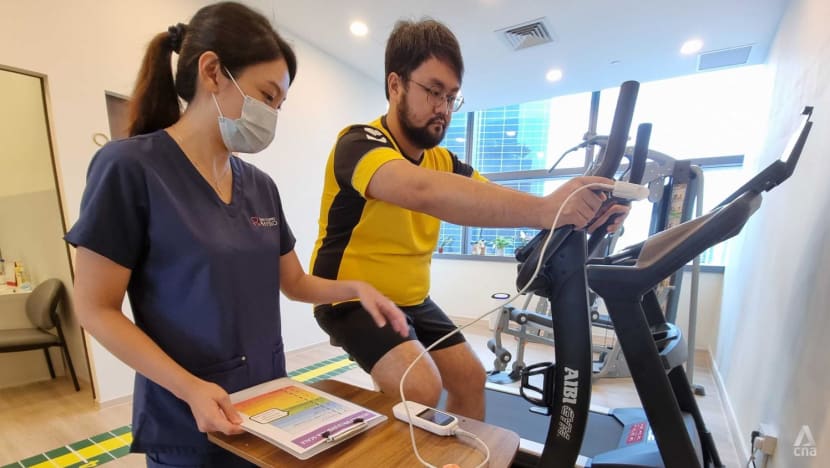SINGAPORE: Ms Doris Ong, 49, has been feeling breathless after strolling quick distances ever since getting COVID-19 in November.
She used to have the ability to stroll dwelling from the bus cease with two luggage of groceries –taking about 10 minutes. But after her coronavirus episode, she as soon as took greater than 20 minutes to stroll dwelling carrying a coconut, which she was ingesting.
She felt so drained that she needed to cease to relaxation just a few occasions, she informed CNA. A month in the past, she additionally felt that her coronary heart was “squeezed” whereas consuming laksa, Ms Ong stated.
Her signs have eased just lately, however she nonetheless feels “weak” in comparison with earlier than; and till now, she’s not sought medical recommendation.
“I feel that it’s still manageable, It’s not (as though) I need to go to A&E … if I really cannot (take it), then I will call 995,” she stated.
About one in 10 individuals report some signs as much as six months after contracting COVID-19, based mostly on knowledge that was revealed in 2021, stated Dr Barnaby Young, head of the Singapore Infectious Disease Clinical Research Network on the National Centre for Infectious Diseases (NCID).
NCID’s “long COVID” clinic has been seeing sufferers with persistent signs after COVID who have been referred by common practitioners, polyclinics and hospitals, he stated.
“An important caveat is that it is difficult to determine which of these symptoms were actually due to COVID versus another condition. Breathlessness is a symptom typically reported after a severe infection,” stated Dr Young.
“With primary vaccination, boosters and the emergence of the Omicron variant, severe infection and by extension persistent breathlessness post-acute COVID is much less common.”
FATIGUE, COUGH, SWOLLEN HANDS
Recovered COVID-19 sufferers have reported a wide range of signs aside from breathlessness, together with mind fog, fatigue, wheezing, palpitations and protracted coughs. This can final for weeks or months after testing unfavourable for the virus.
Ms Jocelyn Ng, who’s in her 40s, stated that she has turn out to be “very sensitive” to any odor or smoke that irritates her throat or airways, setting off a nasty, wheezing cough.
She recounted how her hand as soon as “hardened”, swelled and have become fully numb after she fell asleep on it.
“I had never felt such excruciating pain before … I was crying,” stated Ms Ng. She described how her hand was pulsating, as if her blood was attempting to circulate however couldn’t.
She went to a physician, who suggested her to go to the hospital. But as there was numerous COVID-19 circumstances being handled by the hospitals on the time, she didn’t go, Ms Ng stated.
She finds it exhausting to do housekeeping – when she tried to mop the ground at dwelling, her hand “cramped up and hardened” – so she has employed a part-time helper. And she has bother shopping for groceries as her hand “stiffens” when she tries to hold issues, stated Ms Ng.
The painful swelling occurs pretty frequently on each fingers, so she has been getting a therapeutic massage each week to take care of this symptom, she stated.
She’s additionally placed on weight and feels that she can not train as her “body is very lethargic”.
MORE “LONG COVID” PATIENTS HERE
Medical professionals informed CNA that they’ve been seeing extra sufferers with such signs because the variety of COVID-19 circumstances right here surged in current months.
What was termed “long COVID” has just lately been renamed post-acute sequelae of SARS-CoV-2 Infection (PASC), stated Dr Edgar Tay, a heart specialist on the Asian Heart & Vascular Centre, Mount Elizabeth Hospital. Sequelae refers back to the aftereffects of a previous illness or damage.
The World Health Organization defines this as a situation that happens in people normally three months from the onset of COVID-19, with signs that final for at the least two months, and can’t be defined by an alternate analysis, he stated.
Patients who’ve had at the least two vaccine jabs are a lot much less more likely to develop post-COVID signs, he added.
Dr Adrian Chan, a respiratory specialist from Respiratory Medical Associates, Mount Elizabeth Novena Hospital, stated that he has seen extra sufferers with PASC on the clinic day by day.
Most report gentle higher respiratory tract signs and a few have extra critical indicators like breathlessness, wheezing, chest ache and palpitations.
“Fortunately, for most patients, they will recover with time. The goal of medical management is to optimise function and quality of life during the period of symptoms,” he stated.
Doctors suggested that sufferers who’ve persistent signs or develop new or worsening signs after restoration from COVID-19 go for a medical analysis. They also needs to search assist for signs that impression their lives, reminiscent of these affecting sleep or limiting train.
Dr Steve Yang from The Respiratory Practice stated that he’ll do assessments to see if there may be lung scarring or coronary heart irritation and to rule out different situations, reminiscent of bronchial asthma exacerbation, lung fibrosis or emphysema.
If these are usually not the trigger, then he advises sufferers to step by step resume train and different actions.
“You can expect to have (these symptoms) for the medium to long term, perhaps up to eight months or so. Therefore don’t expect to bounce quickly out of this,” stated Dr Yang.
“If you do recover quicker then that is good news. It’s basically a gradual increase in activity … do small things, and slowly increase the duration and extent of these activities.”
FEELING “HELPLESS”
Mr Tan Wen Chuan, 32, was respiration extra closely than standard after strolling for about 5 minutes from the automotive park to the interview location.
He has been feeling breathless after strolling or gentle exercise since November or greater than 4 months after his bout of COVID-19.
Mr Tan, who had bronchial asthma as a toddler, stated it might probably really feel like an bronchial asthma assault, as he can’t breathe, and he seems like he can’t “fill up” his lungs. This can occur every now and then, even when he’s not lively, he stated.
He described how he typically feels a “knot” in his chest at a selected spot each time he inhales.
“It’s just a constant state of knowing that I have to breathe harder,” he stated.
When Mr Tan went to see a common practitioner, he was informed that the signs would go away in time.
He stated: “I felt helpless, because the doctor said there was nothing you can do about it.”
Later, on a pal’s advice, he noticed a physiotherapist. His therapist, Ms Jaclyn Chow of Heart & Lung Physio, stated there are issues that may be carried out to enhance one’s respiration and physique conditioning whereas one waits for restoration.
Inactivity, in the meantime, may result in structural modifications like dropping muscle mass, which may result in longer-term points.
INFLAMMATION, NARROWING AIRWAYS
Ms Chow defined that the SARS-CoV-2 virus “hooks” onto angiotensin-converting enzyme 2 (ACE2) receptors within the physique, and these cells are concentrated within the higher airways.
“Even when you (test) negative, there might still be some inflammation, that’s why people have residual symptoms … it also causes sensitivity to the receptors when it detects stimuli like dust, change in temperature or wind blowing on your face,” she stated.
This could possibly be why some individuals have a dry cough even after testing unfavourable for COVID-19. The sensitivity may additionally trigger airways to slender – leading to “air hunger”, and may also trigger a sense of not with the ability to breathe out absolutely.
Mr Tan has since discovered strategies and workout routines to assist him breathe higher, and is on an endurance train programme. He’s rather more acutely aware of his respiration and posture, and that has helped him to handle the episodes of breathlessness, he stated.
NCID’s Dr Young stated that post-acute COVID syndrome is “complex and highly variable”.
“Investigation and treatment is tailored to the individual and the symptoms they are experiencing,” he stated.
“Fortunately for the majority, post-acute COVID syndrome is a self-limiting condition and does not require medication. Most will recover with time and a (gradual) return to exercise and other usual activities.”
Lung specialist Dr Yang warned towards intentionally attempting to catch COVID-19 to “get immunity”, saying that there could be long-term implications after contracting the virus.
He added: “Employees and employers should recognise that this is a problem that we are facing, they are not trying to malinger or trying to find ways to escape work. And I think people should understand when people have all these symptoms.”
BOOKMARK THIS: Our complete protection of the COVID-19 pandemic and its developments
Download our app or subscribe to our Telegram channel for the most recent updates on the coronavirus outbreak: https://cna.asia/telegram


Source : channelnewsasia.com
The post Breathlessness, fatigue, persistent cough: Doctors see more cases of ‘long COVID’ in Singapore first appeared on Umorr.








